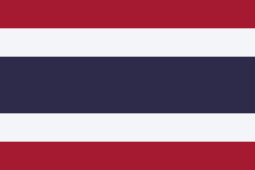This article needs additional citations for verification. (September 2017) |
 | |
| Trairanga (Thai: ธงไตรรงค์, RTGS: thong trai rong), 'Tricolour flag' | |
| Use | National flag, civil and state ensign |
|---|---|
| Proportion | 2:3 |
| Adopted | 28 September 1917 (standardized on 30 September 2017) |
| Design | Five horizontal stripes of red, white, blue, white and red, the middle stripe twice as wide as the others |
| Designed by | King Vajiravudh (Rama VI) |
| Thai: ธงราชนาวี (RTGS: thong ratcha nawi), 'Royal Navy flag' | |
 | |
| Use | Naval ensign |
| Proportion | 2:3 |
| Adopted | 28 September 1917 (de jure) |
| Design | A red disc containing a white elephant (Airavata) in regalia centered on the national flag |
The flag of Thailand (Thai: ธงไตรรงค์; RTGS: thong trai rong, meaning 'tricolour flag') shows five horizontal stripes in the colours red, white, blue, white and red, with the central blue stripe being twice as wide as each of the other four. The design was adopted on 28 September 1917, according to the royal decree issued by Rama VI. Since 2016, that day is a national day of importance in Thailand celebrating the flag.[1]
The colours are said to stand for nation-religion-king, an unofficial motto of Thailand,[2] red for the land and people, white for religions and blue for the monarchy, the last having been the auspicious colour of Rama VI. As the king declared war on Germany that July, some note the flag now bore the same colours as those of the UK, France, Russia and the United States.[3]
- ^ (in Thai) การฉลองครบรอบ 100 ปี การประกาศใช้ธงไตรรงค์ เป็นธงชาติไทย Archived 19 May 2017 at the Wayback Machine Thailand.prd.go.th, Retrieved September 26, 2017.
- ^ "Thailand: A Country Study". Country Studies Program, formerly the Army Area Handbook Program, from the Library of Congress. Mongabay.com. Retrieved 23 July 2011.
Sarit revived the motto "Nation-Religion-King" as a fighting political slogan for his regime, which he characterized as combining the paternalism of the ancient Thai state and the benevolent ideals of Buddhism.
- ^ Duncan Stearn (14–20 February 2003). "A Slice of Thai History: Raising the standard; Thailand's national flags". Pattaya Mail. Retrieved 24 July 2011.
The prevailing – although unofficial – view of the meaning of the five stripes is that red represents the land and the people; the white is for Theravada Buddhism, the state religion and the central purple stripe symbolises the monarchy. It has also been stated that purple was the favorite color of King Rama VI (he born in Saturday). Another account claims the purple (this refer deep blue) was inserted as a show of solidarity following Thailand's entry into the First World War (in July 1917) as an ally of Britain and France....